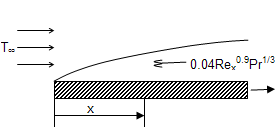Surface shear stress in parallel flow over a flat plate.xls

Description
KNOWN: Heat Transfer correlation associated with parallel flow over a rough flat plate Velocity and temperature of air flow over the plate.
FIND: Surface shear stress 1 m from the leading edge.
ASSUMPTIONS: 1) Modified Reynolds analogy is applicable.
2) Constant Properties.
Calculation Reference
Fundamentals of Heat and Mass Transfer - Frank P. Incropera
The surface shear stress in parallel flow over a flat plate is an important parameter in fluid mechanics, as it determines the drag force acting on the plate. The shear stress is caused by the frictional forces between the fluid particles and the surface of the plate.
In parallel flow over a flat plate, the fluid flows parallel to the plate, and the velocity of the fluid varies from zero at the plate surface to a maximum at a distance from the surface. The velocity profile is typically described by the boundary layer theory, which states that a thin layer of fluid near the surface of the plate is affected by the frictional forces and has a velocity gradient in the direction perpendicular to the plate.
The surface shear stress is typically calculated using the shear stress distribution, which is derived from the velocity profile and the properties of the fluid. For a Newtonian fluid, the surface shear stress can be calculated using the following equation:
τw = μ(dU/dy)|y=0
where τw is the surface shear stress, μ is the viscosity of the fluid, dU/dy is the velocity gradient in the direction perpendicular to the plate, and y is the distance from the plate surface.
The velocity gradient can be determined using the boundary layer theory, which provides equations for the velocity profile in laminar and turbulent flow regimes. The viscosity of the fluid can be determined using the appropriate fluid properties and equations of state.
Overall, the surface shear stress in parallel flow over a flat plate is an important parameter that needs to be carefully controlled in fluid systems, as it determines the drag force acting on the plate. The shear stress can be calculated using the appropriate velocity profile and fluid properties, and it needs to be properly matched with the other design parameters of the system to ensure efficient and safe operation.
Calculation Preview
Full download access to any calculation is available to users with a paid or awarded subscription (XLC Pro).
Subscriptions are free to contributors to the site, alternatively they can be purchased.
Click here for information on subscriptions.
